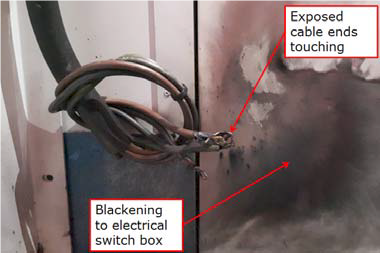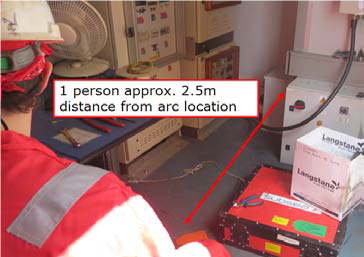Electric Arc Incident
What happened?
During a vessel mobilisation a control cabin for an electric ROV was being installed and commissioned. The cabin’s internal main electrical power cable arced, tripping the vessel’s power circuit breaker. The arcing, witnessed by an ROV technician, came from a coil of electrical cabling which had been left hanging from trunking in close proximity to the cabin’s internal transformer. This cable was the main electrical power feed from the external power source socket to the internal transformer and had been supplied disconnected and with exposed conductors. The cable’s conductors had arced when the cabins electrical system was energised, producing a bright flash and audible bang.
Although there was no actual injury or equipment damage, there was serious potential for both.


What went wrong? What were the causes?
- There was no external power socket available at the workshop base for powering the control cabin during testing and preparation. The work team developed a workaround disconnecting the control cabin’s main electrical cable and hardwiring the power supply from the base directly into the control cabin’s transformer;
- There was no management of change (MoC) process conducted as this operation was seen as a temporary change to the equipment. The change to the transformers electrical input was not formally documented or communicated to the personnel that would be working on the system;
- A combination of inadequate supervision, instruction and experience resulted in the failure to recognise that the main power cable had not been correctly reinstated prior to shipping;
- The pre-mobilisation checklist was also found to be insufficient in detail and did not include a check for testing or inspection of the main power cable;
- Electrical testing of the control van was not considered necessary and was not included in the mobilisation procedure;
- Despite several technicians working in close proximity to the exposed hanging cable, it was not identified as a hazard prior to connection to the ship’s power.
What lessons were learned?
- Ensure power supply requirements are adequately identified before the job starts;
- Worksites should ensure they have an appropriate selection of electrical sockets on site for correct equipment connections;
- Ensure an MoC process is applied to control all temporary equipment modifications;
- Reiterate to work team leaders the importance of effective job briefings, which confirm job expectations and responsibilities in sufficient detail of the work to be undertaken;
- Review pre-mobilisation checklists to ensure they include the requirement for adequate checks for loose or hanging cables, exposed conductors and unsafe electrical conditions before the appropriate testing of the main electrical system is carried out;
- Mobilisation procedures should include checks prior to electrical hook-up for the appropriate testing of electrical cables and inspection for unsafe conditions;
- Roles and responsibilities should be clearly identified and documented on any worksite where electrical commissioning, testing or installation is being conducted.
Members may wish to refer to the following:
- Electrical safety (2003)
- Electrical flash burns (2000)
- Electrician fatally electrocuted (2015)
Safety Event
Published: 2 October 2018
Download: IMCA SF 23/18
IMCA Safety Flashes
Submit a Report
IMCA Safety Flashes summarise key safety matters and incidents, allowing lessons to be more easily learnt for the benefit of all. The effectiveness of the IMCA Safety Flash system depends on Members sharing information and so avoiding repeat incidents. Please consider adding [email protected] to your internal distribution list for safety alerts or manually submitting information on incidents you consider may be relevant. All information is anonymised or sanitised, as appropriate.
IMCA’s store terms and conditions (https://www.imca-int.com/legal-notices/terms/) apply to all downloads from IMCA’s website, including this document.
IMCA makes every effort to ensure the accuracy and reliability of the data contained in the documents it publishes, but IMCA shall not be liable for any guidance and/or recommendation and/or statement herein contained. The information contained in this document does not fulfil or replace any individual’s or Member's legal, regulatory or other duties or obligations in respect of their operations. Individuals and Members remain solely responsible for the safe, lawful and proper conduct of their operations.
